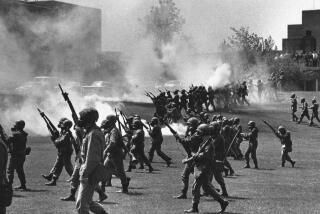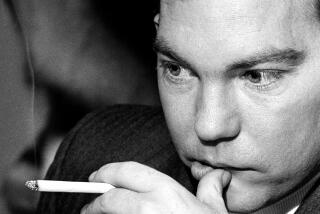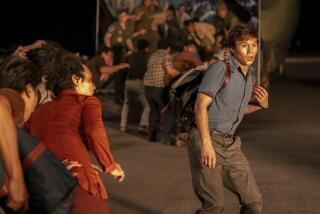A Day of Darkness
MY LAI, Vietnam — Nearly three decades ago, as a young reporter for United Press International, I was escorted by a squad of South Vietnamese soldiers into this Viet Cong stronghold to check out reports that U.S. soldiers had massacred hundreds of civilians.
I suspected that the reports were a fabrication. I had seen the graves in Hue, where North Vietnamese soldiers had buried 3,000 executed civilians, some with hands tied behind their backs, and it hadn’t surprised me. But I didn’t think the Americans were capable of coldblooded killing because, however history may have recorded it, the vast majority of U.S. troops I had encountered were decent people and honorable soldiers.
But one by one, the peasant women of My Lai--most of the men were dead or off fighting with the VC--came forward to tell what had happened on the morning of March 16, 1968.
The 80 or so soldiers who scrambled out of Huey choppers at 7:30 a.m. were from Charlie Company of the 11th Light Infantry Brigade, Americal Division--later described by the U.S. Army as “a typical cross-section of American youth assigned to most combat units.” They met no armed resistance, and by the time they left four hours later, they had killed 504 civilians, mostly women and children.
Ha Thi Gui spoke softly, almost matter-of-factly, on that day so long ago, never looking me in the eye. She had been herded into a ditch with 170 others and had seen the GIs take aim. Wounded, she survived by playing dead under a pile of bodies. Her mother, two children and three brothers and sisters were killed.
“Why did they do this?” she asked.
*
I came back to My Lai the other day, this time escorted by two government officials. Gui, now 73 and gray-haired, wears an eternally mournful expression and speaks hardly above a whisper. I am sure she did not recognize me, although she still never looked me squarely in the eye.
“We have had some Americans come back,” she said, “‘and to tell you the truth, when I first see an American, I am terrified. I think maybe he will kill me. But then after awhile it is all right, and I know there is no danger because there is no war.
“For a long time, maybe 10 years, I could do nothing except sit and cry. I lost everything. The days were lonely. I try not to think about the killing, but living here, in the middle of where it happened, it is not easy to forget or be normal.”
The curator of this living graveyard, Nguyen Thi Thao, led me through the killing fields after telling me it would be appropriate to make a small payment to anyone I interviewed and to leave a donation for the My Lai memorial. Thao, a tall, elegant woman with an air of authority, earns $36 a month and makes ends meet by guarding the bicycles of Vietnamese who while away evenings on the beach a few miles away.
Although the coconut palms were still pockmarked with bullets, no familiar vision came back to remind me this was a place I had once been, a place that over the years had blurred in my mind’s eye as just a collection of rice paddies and thatched-roof homes.
My Lai is different now. There is a two-room museum and a monument to the victims and tombstones placed by the government that list the names of the dead. The ditch where Gui lay covered with bodies has been excavated to appear as it did 30 years ago, and there are women in white aodais--the traditional tunic worn over pants--to guide the 4,000 foreigners and 28,000 Vietnamese who come to My Lai every year.
*
“We do not do this to humiliate the Americans,” Thao said. “We do it so that the Vietnamese will not forget, so our schoolchildren can understand the suffering of their elders and learn from history.”
Along the dusty paths through clusters of villages, children in blue shorts giggled and shouted, “My! My!” (“American! American!”) at the sight of me and tagged along, tugging at my shirt. Elders stared from bamboo thickets, curious but not hostile. Nearby in a field of chest-high corn, a stone monument was carved with the words: “Greve yard of 75 villagers killed by G.I. on March 16, 1968.”
Phan Pat, 70 and toothless, was wounded in the massacre that took the lives of 11 members of his family. Cradling his grandson in his arms, he told me, reluctantly at first, how three soldiers came to his home on the fateful morning, looked around and left. Then, he said, they argued outside with a fourth soldier who appeared to be giving them an order. They returned and started shooting.
“I do not hate Americans,” Pat said, “but I hate the Americans who did the killing. I can remember the faces of only two because I was so afraid. Sometimes I see a foreigner, and it is like his face fades away and becomes the face of one of the Americans.”
The guides at the museum recounted the story of My Lai in a straightforward fashion without ideological embellishment. But time has made their memories selective. There were no Viet Cong in My Lai, they said, only peasant farmers, and when the Americans came that morning, they came expressly to kill civilians.
Actually, this area of Quang Ngai province was such a stronghold of the 48th Viet Cong Battalion that the South Vietnamese government had declared it a “free-fire zone,” meaning that everyone was considered the enemy. For Charlie Company, casualties had mounted steadily in the late winter of 1968 because of VC mines, booby-traps and sniping, and when the unit was briefed by intelligence officers on the night of March 15, it was told that the morning’s mission would meet heavy resistance.
“The attitude of all the men--the majority, I would say--was a revengeful attitude,” one soldier, Gregory Olson, told the 1970 military inquiry into the massacre. “They all felt a little bad because we lost a number of buddies to My Lai.”
Retired Gen. H. Norman Schwarzkopf, the allied commander in the 1991 Persian Gulf War, was a battalion commander in Vietnam at the time of inquiry, in charge of the region that included My Lai. Land mines and booby-traps, he wrote in his autobiography, “It Doesn’t Take a Hero” (Bantam, 1992), continued to sap his troops’ morale, just as it had that of Charlie Company.
“While I abhorred the massacre at My Lai, I could also imagine how it might have happened,” he wrote. “I could read the emotions on the faces of my own men.
“If I had said: ‘The people in that village obviously knew this mine was here; in fact, one of them probably planted it. Go clear the place out,’ they’d have killed everyone in sight.”
*
At the My Lai museum, amid huge photos of the massacre that appeared in Life magazine in 1969, one of the guides was telling a group of stunned visitors from the Netherlands about the United States’ darkest day in Vietnam.
“There were seven helicopters, and 170 people were ordered into that ditch and killed,” she said, pointing to a photo. “After that, 11 were marched over here and shot. . . . That picture there, that’s Lt. William Calley, who directed the soldiers.”
Calley, an unimposing soldier whose men used to joke about his inability to read topographical maps, was convicted in a military court on 22 counts of murder. Sentenced to life at hard labor, on 22 counts of premeditated murder, he served only three years under house arrest at Ft. Benning in Columbus, Ga.
After an unsuccessful tour on the college lecture circuit, at $2,000 a speech, and appearing on the cover of Esquire surrounded by Asian children, Calley dropped from public view. He does not discuss My Lai, even with friends, and continues to turn down interviews, some involving large sums of money, that precede each major anniversary of the massacre.
Calley is 54 today, balding, bespectacled, overweight. He is married, with a teenage son, and runs a successful jewelry store in Columbus started by his father-in-law.
One survivor of the massacre, Pham Thanh, 65, hoed at a row of potatoes the other day and said, no, the name Calley didn’t mean anything to him. “I know of only one American from the killing who came back,” he said. “It was five years ago, and I met him and he cried. His name was Thomas and he was a hero in this village.”
“Thomas” would be Hugh Thompson, a chopper pilot who flew over My Lai while the massacre was taking place. He landed and told his door gunner, Lawrence Colburn, to train his M-60 on the GIs and “blow them away” if they harmed any more villagers. The crew flew 10 civilians to safety, pulled a bloodied baby from a pile of corpses and was responsible for stopping a killing spree that could have claimed dozens more lives.
*
On Friday at the Vietnam Veterans Memorial in Washington, Thompson, who now counsels veterans in Lafayette, La., was awarded the prestigious Soldier’s Medal. Colburn, a salesman in Woodstock, Ga., and a third crewman, Glenn Andreotta, who died in Vietnam three weeks after the massacre, will also receive Soldier’s Medals.
Thompson will be at My Lai, along with about 30 former U.S. servicemen and a host of Vietnamese officials, for ceremonies marking the massacre’s 30th anniversary. They will ask themselves, as so many have, what the lesson of My Lai is. And they will probably not come up with an adequate answer.
A moral tragedy, to be sure, but was it an aberration or the evitable consequence of a war in which the body count was the bottom line? Was it the result of failed leadership in the field or of soldiers carrying out a failed policy formulated by higher commands? Was it one of the awful, inexplicable events that can be dismissed simply because war does bad things to good people?
In the end, they probably won’t come up with any more satisfying explanation than the observation that a visitor from England, Neil Proctor, wrote in the My Lai museum’s guest book: “The heart of darkness in a country of so much light.”
More to Read
Sign up for Essential California
The most important California stories and recommendations in your inbox every morning.
You may occasionally receive promotional content from the Los Angeles Times.










